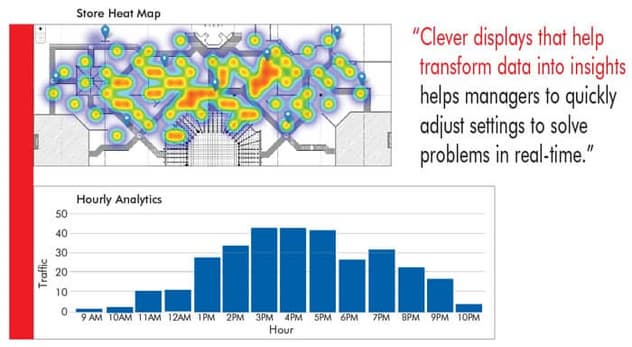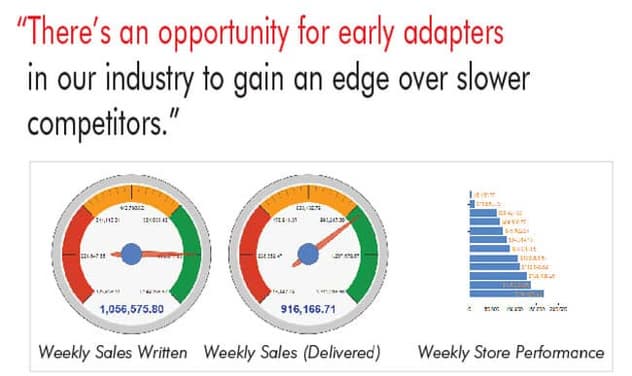
Mobile analytics can prevent common causes of shopper anger & disappointment.
Winning retail sales teams are armed with powerful tools such as effective branding, advertising, store layout, brand alternatives, sales skills, promotions, financing and much more. With these tools, it is the sales team’s mission to create a positive buying experience for every customer.
What happens when these tools fail? Imagine the following scenario: a couple walks into your store and are greeted by a well-trained, smiling sales rep. They want to buy a recliner. The rep deftly takes them to the correct section of the store, explains about the different products, subtly guides the couple toward the most popular choice, and convinces them that it’s the perfect addition to their home.
At checkout, both the salesperson and shopper discover that this particular recliner is out of stock and cannot be delivered for another three weeks.
The couple, angry and disappointed, leave the shop, never to return. A perfect sales journey is overturned at the last moment because the RSAs data was not up-to-date.
Could this situation have been prevented? Yes, with the use of mobile analytics in the hands of the sales associate.
Mobile Analytics
Mobile analytics refers to the collection of real-time data, its study, and presentation as actionable insights. It relies on mobiles to both input data and output the right information to the right person at the right moment (often called just-in-time content).
What the sales team cannot be expected to remember or know, their mobiles certainly can. Giving the sales team access to advanced analytics on their mobiles augments their knowledge with a whole new array of data, giving them that much more power to drive sales and keep a store competitive.

Mobile analytics can provide sales associates with immediate, up-to-date information on stock availability, price fluctuations, trending products, new launches, and more. At the click of a button, the RSA in the above example could have pointed the couple towards a recliner that was in stock, and simultaneously alerted the back office about the out-of-stock situation.
A Sales Management Boon
Salespeople are uniquely positioned to understand client behavior. The addition of mobile analytics allows them to capitalize on that understanding by sending clear, relevant data back to the store or sales managers. Clever displays that help transform that data into insights, help managers to quickly adjust settings to solve problems in real-time, rather than having to wade through crude data gathered in monthly reports.
Here’s an example of how this might work:
1. A salesperson shows a coffee table to a potential customer.
2. She uses her mobile to pull up a full product profile and quote the most accurate, up-to-date data.
3. The customer decides not to purchase that coffee table in favor of a competing brand.
4. The sales associate infers a reason for this decision and feeds that information into her mobile with a single click. For example, the price was too high, the table was out of stock, or the size, color or materials weren’t appropriate.
5. Analytics software aggregates this and similar reports from salespeople to get a clear understanding of why the table isn’t selling. In this case it might be that 35% of customers preferred a taller table, and 52% of customers preferred a cheaper table.
6. Sales managers and buyers review the data to recognize recurring problems and offer solutions, such as to adjust the table’s price, change its in-store location to a display of lower coffee tables, where it might fit in better, or move the table to clearance and purchase other stock.
This ability to monitor, in real-time, the varied factors affecting sales from the floor, has proven to give managers many more opportunities to optimize sales, stock management, placement, discounts, promotional campaigns, and so on.
The Bigger Picture
Mobile analytics allow more than in-store gains. They can boost cross-store improvement in big furniture retail chains, and keep retailers abreast of competing online businesses.
To obtain this bigger picture, retailers must standardize and curate their inflow of data. Stock management software must converse with point-of-sale software, with workers’ mobiles, with online promotional campaigns, and with online competitors to create a picture of furniture retail in full context. This high level of communication and adaptability is in part possible due to advanced cloud services that allow synchronization with multiple sources, and the generation of reports and insights at the highest level.
Furniture retailers who manage each store in a chain separately, and at best compare their revenue and other generic metrics monthly, can now afford to do better. Mobile analytics allows these retailers to draw cross-store insights, run cross-store tests, plus optimize promotions, product launches, displays, pricing, and much more. This finer granularity is made possible by efficient metrics collected by sales associates and reported in real time via mobile analytics.
It may sound complicated, but it’s not. For example, to conduct A/B testing on a new product to find its optimal price, you would just do the following:
1. Give the new product a price ‘X’ at one store, and price ‘Y’ in another.
2. Collect sales data on the ratio of potential customers to actual sales of the product at each location.
3. Quickly and efficiently decide which price point works best.
Live reports from the furniture sales floor also allows managers to easily analyze and compare the efficiency of stores, managers, and individual salespeople.
Happy Sales Teams & Clients
Detailed sales reports and analysis take time to produce and even more time to sift through to glean useful insights. As a result, in-store sales teams rarely peruse such data for its fullest potential. This creates a gap between how they “sense” the field, and how the marketing department sees it through cold reports. This gap can cause alienation between sales teams and marketing directives.
Mobile analytics allows sales teams to feel they are part of the process, more influential, and responsible.
With the help of mobile analytics, sales associates can be confident that the highly accessible data on their devices is always organized, up-to-date, and official. This boosts confidence in their ability to recommend the best options, which in turn contributes to the establishment of rapport with customers. Sales teams tend to become more energetic and active using this technology, and their enthusiasm facilitates a better shopping experience.
Mobile analytics enables the kind of friendly competition within sales teams that Collins and Porras speak so highly of in their book, Built to Last. It also encourages personal excellence and reinforces a sense of being seen and valued by management.
The Opportunity
A high percent of Fortune 500 companies are turning toward mobile solutions. They equip their sales teams with mobiles or tablets, and incorporate mobile analytics in day-to-day decision-making. This approach often shows strong results not only in sales, but also in efficiency and timeliness, making these companies the leaders in their fields.

The furniture industry has been very slow to adapt to this new reality. The good news is that there’s an opportunity for early adapters in our industry to gain an edge over slower competitors. With all the advantages stacked in favor of mobile analytics, there is no reason why furniture retailers should not leverage this technology for success.
Getting Started
Here are a few things to consider before you implement mobile APPS into your stores.
- Create a dual wifi network; one for your staff/company that is secured, and an open network shoppers can use, set up just for your guests.
- Make sure your staff has access to a good strong wifi signal that works across your whole store, with secured/password restricted access for employees only.
- You MUST have internet access with a strong bandwidth signal throughout the store. Consumers have no tolerance for anything less.
- If you develop a Mobile APP that is data intensive, include both IOS and Andriod devices to account for every consumer preference.
- Work with your IT team, or an IT provider who knows and understands Mobile Applications and their implementation.
- The mobile APP must be extremely easy to use.
- The APP must be able to read or “read & write” from your back office POS database, in real time, for updates, APP improvements and more.
Amitesh Sinha is a technology consultant based in North America. With over 20 years of experience developing and deploying solutions for retail, Sinha has gained a reputation for home furnishing software solutions, furniture software, POS furniture software, and re-engineering of software with extended features. His company, iConnect offers business technology solutions that integrate with most P.O.S. systems to make them more efficient and user-friendly. For more information about this article or any retail technology question contact Amitesh at 703-471-3964, amitesh@iconnectgroup.com or www.iconnectgroup.com.